Coercion against children - better solutions
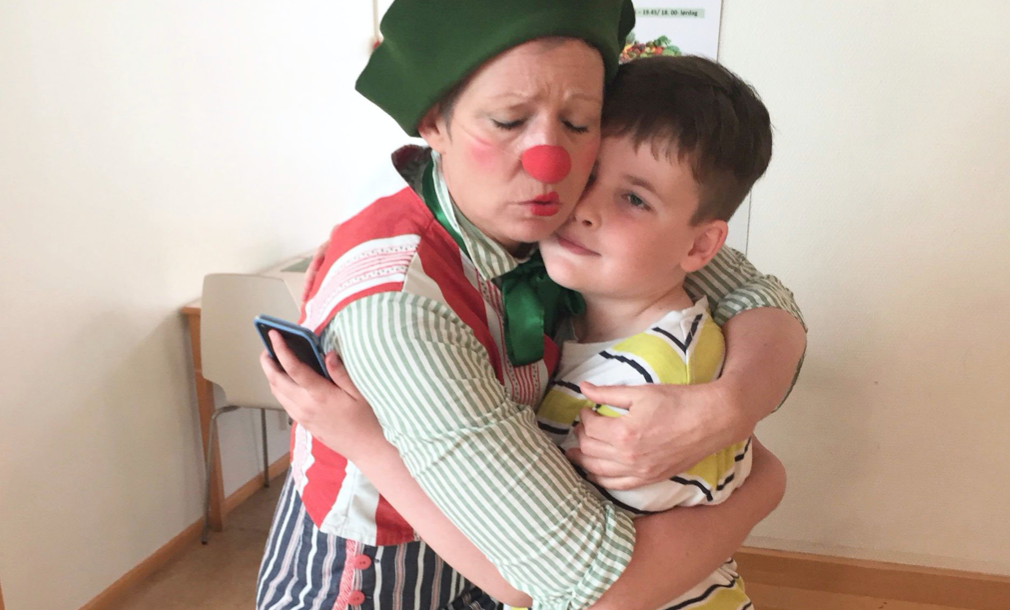
The use of coercion against children to carry out examinations and medical procedures is a controversial, but still little talked about topic. Children in hospital, tragically, have no laws to protect them from forced use. It is therefore very important that parents are aware of their user rights and parental rights, so that they dare to put their foot down, or advocate for the child's need for accommodation when carrying out examinations and medical procedures.
In the Patient and User Rights Act Section 3-1 it says that "Emphasis must be placed on what the child means, in accordance with the child's age and maturity."
In the Patient and User Rights Act Section 4-1 it says that "Health care can only be provided with the patient's consent, unless there is a statutory authority or other valid legal basis for providing health care without consent. In order for the consent to be valid, the patient must have received the necessary information about their state of health and the content of the health care."
In the Patient and User Rights Act Section 4-4 it says that "The parents or others with parental responsibility have the right to consent to health care for patients under the age of 16."
Very few parents are informed about these sections and this legislation when they enter hospitals desperate for help for their beloved young children. One thing is certain, if all parents of children in hospital had been informed that "even if the child does not want to and will protest and cry, they plan to use coercion to carry out procedures that are perceived as scary and painful for the child, despite the fact that there are other possible solutions to carry out", followed by the question: "Do you parents agree to this?" - then far more parents would have become aware of their rights and said no. That is why it is so important to know the child's rights, and your rights as a parent, in order to make informed and good choices on behalf of children in hospital.
The use of coercion against children must be a last resort and only acceptable in acute, life-threatening situations, where there is a danger to life and health.
You can read about the turning point in connection with the use of coercion against children for our chairman Bettina Lindgren i The bioengineer.
You can read the case here about the boy of Gyri, a board member of Løvemammaene Nord, who was subjected to coercion in a hospital, where the mother complained to the State Administrator and was upheld that the hospital violated the responsibility requirement. This case is important because it sets a precedent, as there are no Norwegian laws that protect children against coercion in the health sector.
And here you can read a great one article in Bioingenieuren about how to carry out blood tests without coercion.
Some general advice for you as a parent
NB! The advice is not intended for acute and life-threatening situations.
Parents should
- talk to healthcare personnel about concerns in advance and address the need for arrangements and any need for medication.
- make demands and tell what is not accepted - be the child's spokesperson.
- prepare, prepare, prepare!
- ask for carpooling if the child has several appointments that involve stress, anxiety and anxiety for the child.
- never promise something you can't keep to the child!
Do not say “it doesn't hurt” when the likelihood that it will hurt is present. This will only result in the child not being able to trust you the next time you say it. Be honest. - trust your gut feeling.
- Dare to say no when it feels wrong.
- don't accept anything you wouldn't accept for yourself.
- talk positively about the child's healthcare personnel. Avoid expressions such as "the stupid doctor" or "the mean nurse".
- if admitted: Do not let the child be woken by blood tests and the like.
- ask the hospital to speak to CL team if the child shows signs of anxiety and trauma in connection with hospital visits and procedures.
Preparations
Children have different starting points for how well they can prepare before examinations and procedures in hospital. Age, general condition, communication capabilities and cognitive function play a significant role. Preparations must therefore be adapted individually, but can e.g. involve the following:
- Look at situation pictures.
- Use ASK, or similar symbol cards/picture cards. (Further down in this article you can download a small symbol pack we have made).
- Watch the video on the hospital's website or on YouTube. On YouTube you can e.g. watch video and hear the sound of both CT and MR machines, something that can be good to be prepared for if you are small, but still big enough to take such examinations without anesthesia.
- Talk about what is going to happen, what is scary and what wishes the child has.
- Thematic play with hospital equipment.
- Some hospitals have got mascots that can be nice to read about, e.g. there are many different mini-stories about hospital mouse Rasmus on OUS's website.
- Books that may be relevant: "Karsten has to go to hospital", "Alfred teddy bear in hospital", "Little sister at the emergency room", "Thomas goes to the doctor", "Jo and Jenny at the hospital", "Supert hospital", "Watch and learn the hospital" and "Ella at the hospital".
- Play Hello game which opens the door to talking about difficult situations and feelings in a child-friendly way.
- Babies are very difficult to prepare and explain to. Here, anesthetic patches/cream, sugar water, pacifiers and proximity to one of the parents during the procedure should be attempted as far as possible.

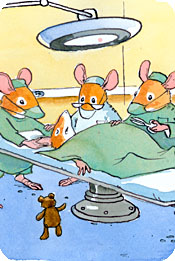

Download symbol pack here:
Note! This is not an exhaustive and complete package of symbols, but a small collection that we have made ourselves in the hope that it may be of help or inspiration. Try to make your own or contact us if you are missing any symbols, and we will try to be helpful.
Good time
Taking your time is very important!
Healthcare personnel should take the time to talk about what will happen, preferably showing how things are done on a stuffed animal or on parents if possible. They should also take the time to ask the child if they understand why and how, if the child has any questions, and tell them about the prize that awaits afterwards. It may be an idea to make arrangements with the child before the procedure if possible. The agreement may involve a fun code word, let the child create rules for implementation or that someone must dance the "macarena" while it all takes place. The possibilities for good implementation are many - you just have to use your imagination and try to adapt to the type of procedure, the child's functioning and age to the best of your ability.
Let children have control over their own body and situation
You just have to imagine how it feels to have strangers hold you down, pull out devices you've never seen before, perhaps stick a needle through your skin or try to push a probe through your nose and further down your throat while you vomit, while frantically resisting to no avail. You lose complete control over your body and the situation you find yourself in. Focusing on this when children are going through examinations that can seem scary or procedures that can be painful, is the alpha and omega of being able to carry out in the best possible way.
Children who experience respect for their bodies and can trust that they will be heard when they say "no" or "stop", will feel that they have control over both their bodies and the situation, despite the fact that the procedure is a challenge. It will also create trust in healthcare personnel and give the child a sense of mastery when procedures can be carried out without holding and intense fear. This can be solved by using the points above, preparations and plenty of time, as well as by putting them into use stop sign. It can e.g. be a red sign, red light switch or a card from ASK symbols for non-verbal children, which are used by the children when they want to stop the procedure.
Note!
Healthcare personnel must also have a particular focus on those children who do not have a verbal language or can express themselves adequately, and who cannot move/resist. Here children's departments and bioengineers/labs should. have good routines for preparations, like to use symbol cards, and have a close dialogue with the parents.
Just because they can't resist or say "stop" doesn't mean it's just feeding. That child may be just as scared as the child who screams so loudly that it is heard throughout the ward.
Nitrous oxide
Several children's departments have started to use nitrous oxide for children. There are no serious side effects when using nitrous oxide and it can help to reduce both anxiety, fear, pain and trauma in connection with short-term medical examinations and procedures.
Figures from the Hospital in Østfold show 92 % passability of procedures using nitrous oxide. These are fantastic results that underpin what a wonderful aid nitrous oxide is - also for children and young people.
Ask for nitrous oxide at your child's hospital. If your child has major difficulties with carrying out procedures and a lot of trauma in that connection, you can try to ask to be referred to a nearby hospital that offers nitrous oxide.
Read about The nitrous oxide enthusiasts in this post from OUS.
In this article from Sykepleien you can read about a boy who receives nitrous oxide during a spinal puncture.
Here you can read about nitrous oxide use at Hammerfest Hospital.
- It is incomprehensible that nitrous oxide has not been introduced in all children's wards, says pediatrician Jörgen Landehag.The journal for the Norwegian Medical Association has also discussed the use of nitrous oxide for children, which you can read here.
Anesthetic plasters and preparations

Emla patch: An anesthetic patch that can be attached to the skin well in advance of procedures that involve injections. The patch should be taken 1 hour before blood sampling, and taken off 10-15 min. before blood sampling. It can be difficult to see/find the blood vessels if it is removed just before. Emla is also available in the form of a cream in a tube that can be applied and a tight patch applied over it.
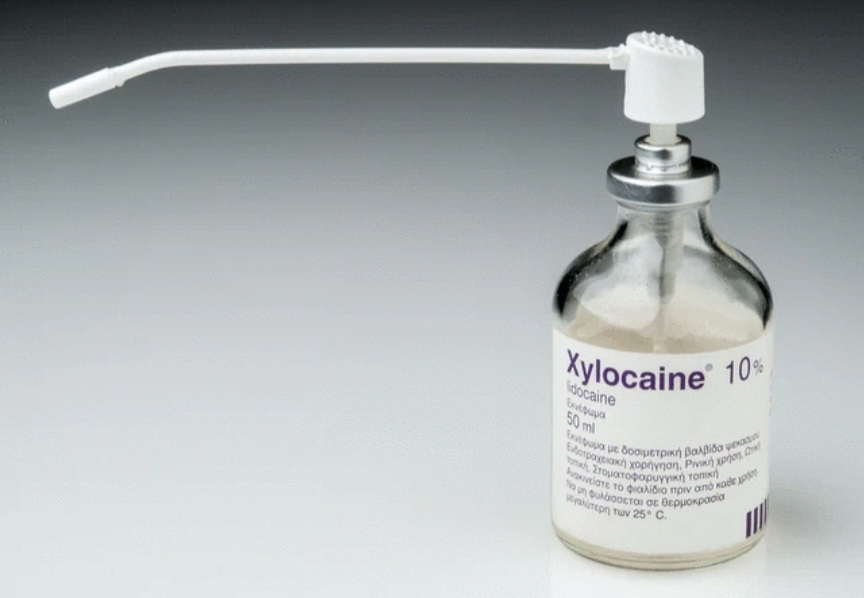
Banana spray (Xylocaine spray): A light anesthetic spray that smells good, a bit like banana, but probably doesn't have as good an effect as Emla plasters.
Xylocaine (gel): Local anesthetic gel such as can be used when changing a button in the stomach or when changing a tracheostomy. Can also be used when introducing a catheter into the urethra or rectum (e.g. children who empty themselves with enemas etc.), as well as for superficial, painful skin damage and tears in the rectum. You must have a prescription for this.
The hospital clowns
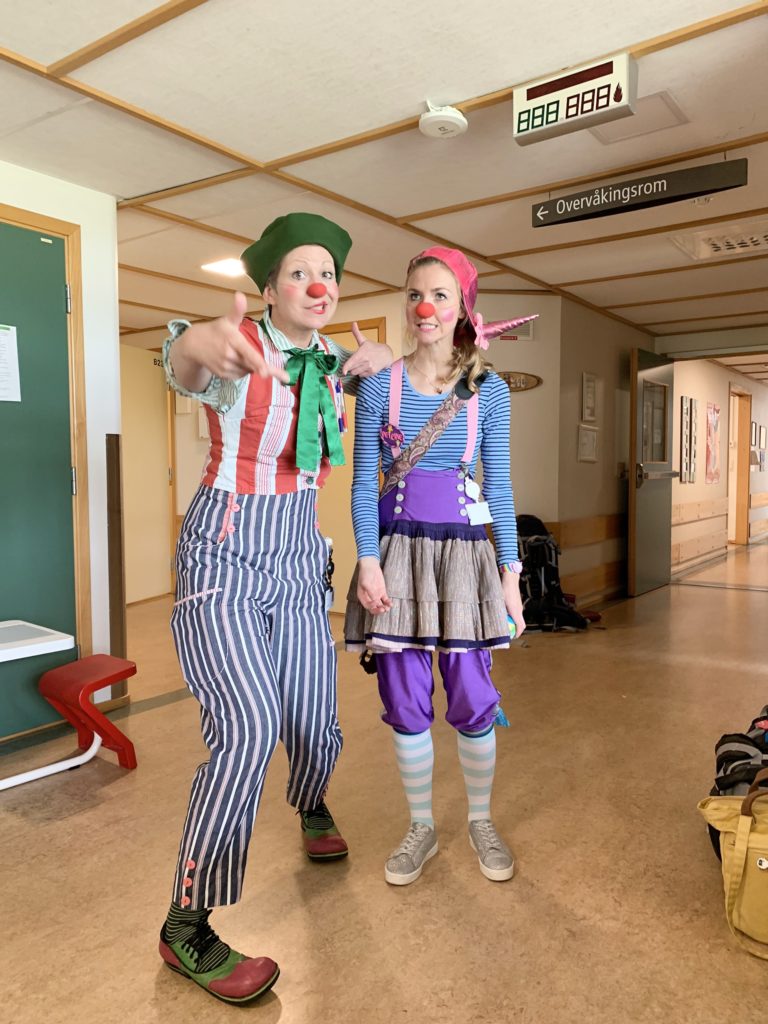
The hospital clowns meet children and young people admitted to hospital. Their focus is to see the healthy in the child, and meets the child at their level. The hospital clowns can help during medical treatments, and it has been proven that the presence of the clowns reduces the need for sedatives and the unwanted use of coercion.
Some clowns also have special training in taking part in more advanced procedures, such as anaesthesia, as well as within the pediatric palliation field.
Research shows that laughter and joy reduce pain, strengthen the immune system and cause less stress, which the Hospital Clowns work towards on a daily basis. 30,000 small patients they meet each year.
If you have a child who is struggling and is scared in hospital, you can contact the Hospital Clowns and ask for assistance. The coordinators in the children's wards at the hospital must also be able to assist in communicating the fear and need for clowns, and coordinate with the clowns if necessary. You can find the hospital clowns these hospitals.
Sedative medications
It has been common for many years to use sedative drugs such as Dexdor, Midazolam/Dormicum and the like for children. Sedative medications provide a mild sedation ("intoxication"), when the child does not need anesthesia. Some children's wards are restrained when it comes to the use of sedatives, both because it can cause side effects and because a minimum of medication is desirable, and in some there is still too little focus on avoiding coercive use against children. Sometimes it will still be absolutely necessary for children to be able to carry out procedures without trauma, but it is important to note that this not is pain-relieving – it must possibly come in addition. Especially in children with a long-term need for follow-up and treatment in hospital, where the less invasive solutions mentioned in this post do not work and where nitrous oxide is not available, sedative medications are something to consider precisely to prevent trauma and psychological difficulties in the future.
Anesthesia
Some children will because their illness/diagnosis significantly struggle to carry out certain procedures, and there are also quite a few examinations that are not possible or justifiable for children to carry out in an awake state, which in turn will trigger the need for anaesthesia.
Anesthesia can be given in two ways: Infusion via intravenous drip, or "gas" on a mask that the child breathes in until he falls asleep. Infusion via Veneflon is the most common way of giving anesthesia to children, but it requires that the child be stung while awake before the anesthesia is given. This can be difficult to achieve if children are very afraid of needles or have trauma, and then gas on a mask may be more gentle for some. The IV can then be inserted as soon as the child falls asleep from the gas, without the child needing to be afraid or feel the sting. Ask to speak to anaesthetist if you think this might be a solution for your child.
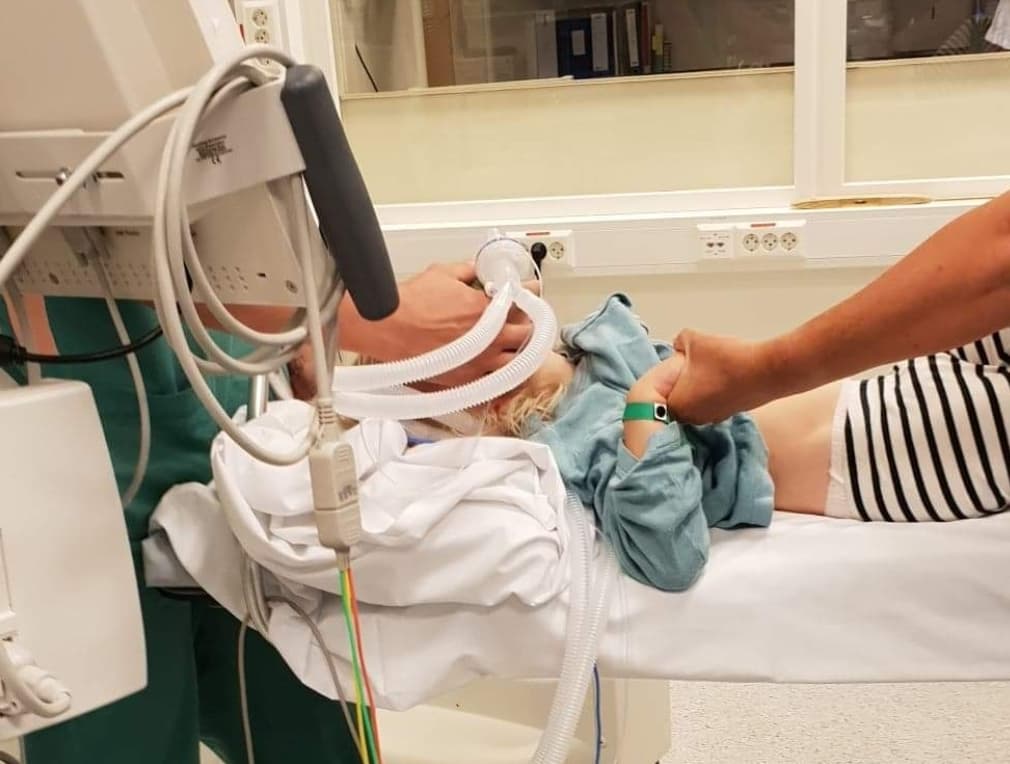
VAP
May be relevant for children and young people who have to take regular blood tests/receive regular infusions and/or are difficult to inject. VAP is short for Venous Access Port. This is a small chamber that is placed under the skin. The chamber has access to a blood vessel through a thin tube (catheter). The VAP can be used to take blood samples, give chemotherapy and other drugs/fluids. One can also give blood and intravenous nutrition. The VAP can withstand up to 2,000 injections and can remain in the body for several years.
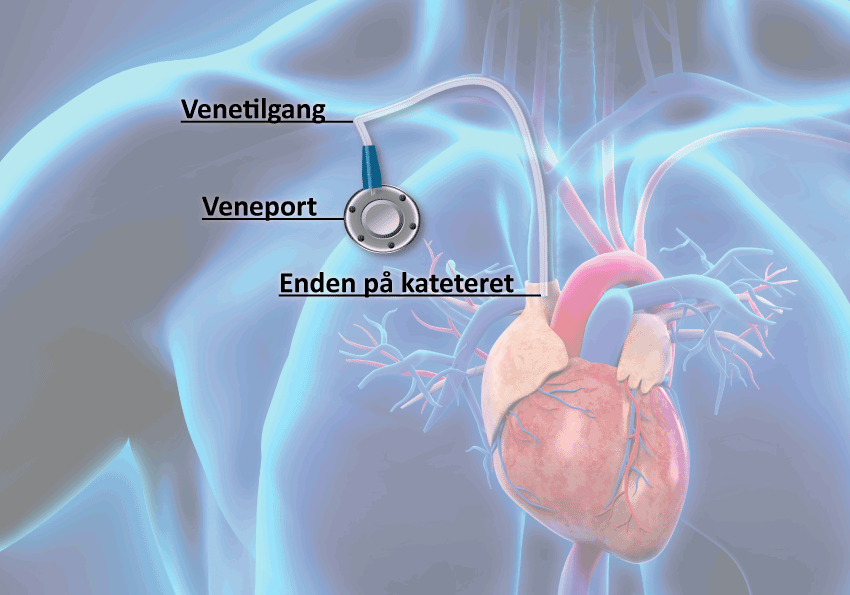
Premiums
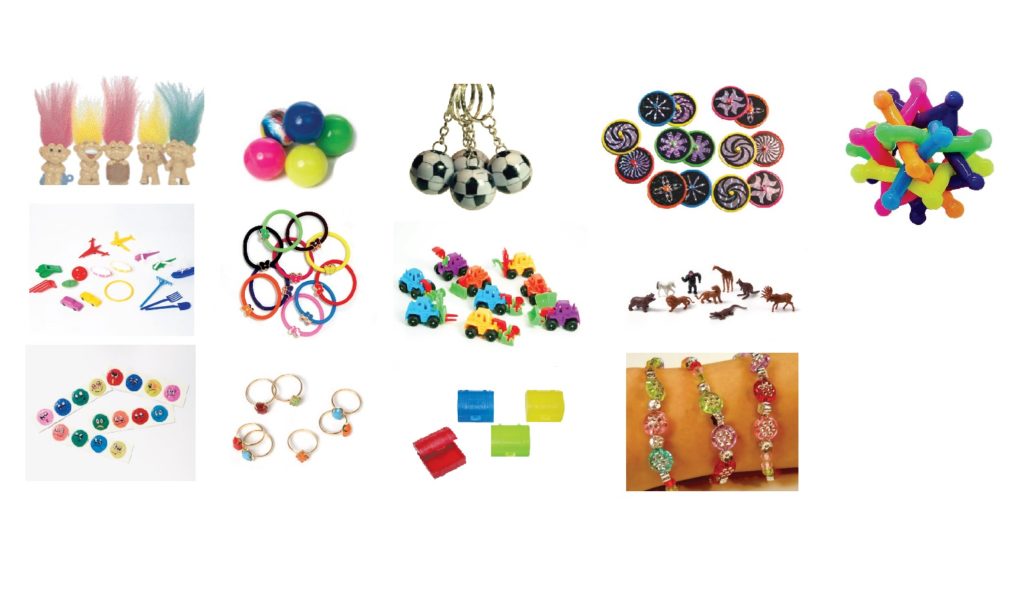
Children must always receive a prize regardless of age and function!
Unfortunately, we constantly experience and hear about healthcare personnel who do not give premiums to the very smallest children, large children, and children who have significant cognitive and communicative challenges, such as e.g. unable to see or move, or who healthcare personnel for various reasons assume do not enjoy premiums. Parents should be informed of this if they are exposed to it, so that the practice does not become the norm.
Children must always be offered a prize!
Hospital Children Foundation ensures that the country's hospitals and children's wards have premiums for all children. In addition, they organize face painting, give out Christmas presents and Easter eggs etc. to make children's stay in hospital a little better.
Pearls for Heroes
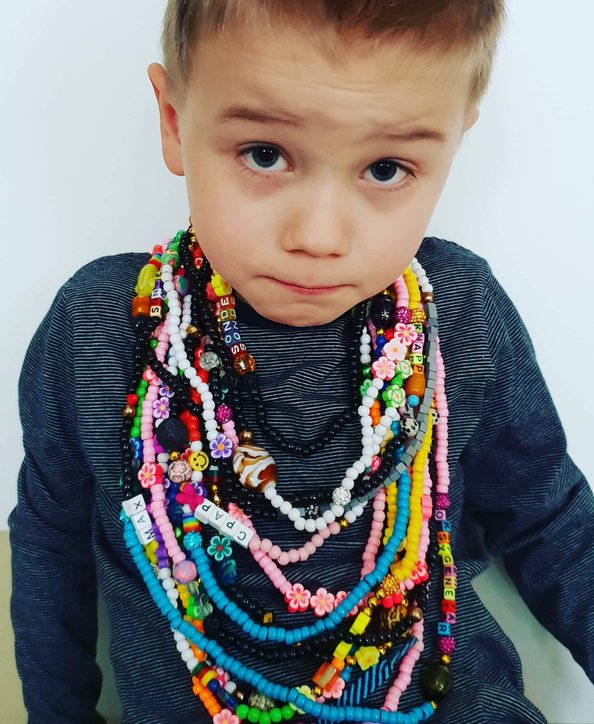
Pearls for Heroes is a pearl program for children up to 15 years of age who are chronically or long-term ill. The pearl program aims to help sick children to both see for themselves and show the world how brave they are. The pearls make invisible diseases visible, give the children ownership and more control over their own health. A reward for all trials. Every bead matters. Something they can be proud of. A kind of therapy. The extra fine and special pearls – the pearls of courage – are a symbol of what was really, really difficult, but which they mastered nonetheless.
Note! There can be quite a bit of waiting time, because it is run entirely on a voluntary basis by one person.
Complain about unnecessary/disproportionately use of coercion
Again, the advice is not intended for acute and life-threatening situations.
All parents who experience that their children are exposed to unnecessary use of coercion, or disproportionate use of coercion in the healthcare system, should complain!
Unnecessary forced use means e.g. use of coercion without having tried other solutions first, or that one carries out procedures that could have waited until later, another day or that could have been coordinated with other investigations, with coercion. All coercive use that could have been prevented by doing it in a different way, using a different approach or that could have been remedied with medication, you as parents should consider whether it was necessary. The same applies to coercive use that you, as parents, were not given the opportunity to make a clear and informed choice about consenting to.
Disproportionate coercion means the use of force in such a way that the child is exposed to what can only be defined as abuse, e.g. in that many adults are used to hold the child and carry out the procedure(s), or that the child suffers pain, bruises or the like due to the forced use.
A complaint is directed to the department/hospital where the incident took place. Read more about how to complain to the hospital here.
You can complain further to The State Administrator if you are not successful in your complaint from the hospital.
- Published:
- The lion mothers
- Published:
- The lion mothers